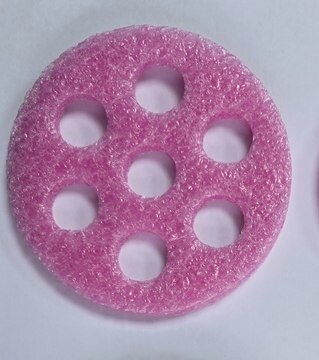Unfortunately, there is no direct correlation between linear pore size measurements and nominal pore ratings based on retention of globular proteins (MWCO). However, several publications are available describing the separation of QDs by size based on the membrane MWCO. Please see the link below to review an example of one such publication:
https://pmc.ncbi.nlm.nih.gov/articles/PMC8271461/
D9652
Dialyseschlauch, Cellulosemembran
avg. flat width 33 mm (1.3 in.)
Synonym(e):
Cellulose Dialysis Tubing, Cellulose Membrane, Dialysis Membrane
Größe auswählen
€ 156,00
Größe auswählen
About This Item
€ 156,00
Empfohlene Produkte
Mittlerer Durchm.
21 mm , when full
Mittlere (flache) Breite
33 mm (1.3 in.)
Kapazität
~110 mL/ft
Suchen Sie nach ähnlichen Produkten? Aufrufen Leitfaden zum Produktvergleich
Verwandte Kategorien
Allgemeine Beschreibung
Verpackung
Qualität
Angaben zur Herstellung
Lagerklassenschlüssel
13 - Non Combustible Solids
WGK
WGK 3
Flammpunkt (°F)
Not applicable
Flammpunkt (°C)
Not applicable
Hier finden Sie alle aktuellen Versionen:
Analysenzertifikate (COA)
It looks like we've run into a problem, but you can still download Certificates of Analysis from our Dokumente section.
Wenn Sie Hilfe benötigen, wenden Sie sich bitte an Kundensupport
Besitzen Sie dieses Produkt bereits?
In der Dokumentenbibliothek finden Sie die Dokumentation zu den Produkten, die Sie kürzlich erworben haben.
Kunden haben sich ebenfalls angesehen
Verwandter Inhalt
Dialysis Tubing
-
What is the molecular weight cut off for the Dialysis tubing cellulose membrane avg. flat width 33 mm (1.3 in.) with product number D9652? Is this suitable for purification of Quantum Dots which have size range from 2-10nm.
1 answer-
Helpful?
-
-
Which organic solvents can be used with these membranes?
1 answer-
Regenerated cellulose membranes are typically compatible with acids and alcohols. Organic solvent compatibility varies from compound to compound. However, the solvent concentration, temperature, and exposure time are factors to be considered. Please see the table below to review the general membrane compatibility with various solvents.
Helpful?
-
-
how do I prepare the tubings before usage?
1 answer-
Instructions have been provided in the 'Preparation Note' in the 'DESCRIPTION' section.
-Wash the tubing in running water for 3-4 hours to remove glycerol included as a humectant.
-Treat the tubing with a 0.3% (w/v) solution of sodium sulfide at 80°C for 1 minute to remove sulfur compounds.
-Wash with hot water (60°C) for 2 minutes, followed by acidification with a 0.2% (v/v) solution of sulfuric acid, then rinse with hot water to remove the acid.
This tubing will retain most proteins of molecular weight 12,000 or greater.Helpful?
-
Active Filters
Unser Team von Wissenschaftlern verfügt über Erfahrung in allen Forschungsbereichen einschließlich Life Science, Materialwissenschaften, chemischer Synthese, Chromatographie, Analytik und vielen mehr..
Setzen Sie sich mit dem technischen Dienst in Verbindung.






